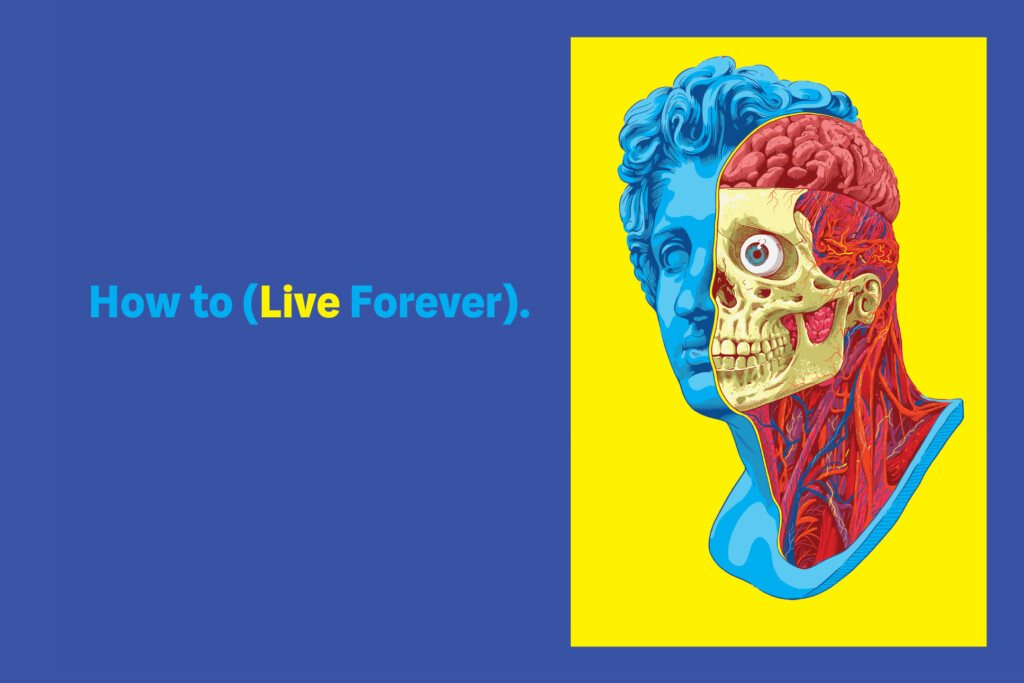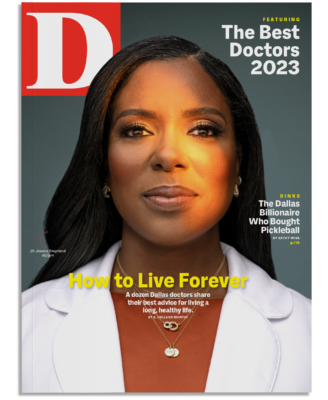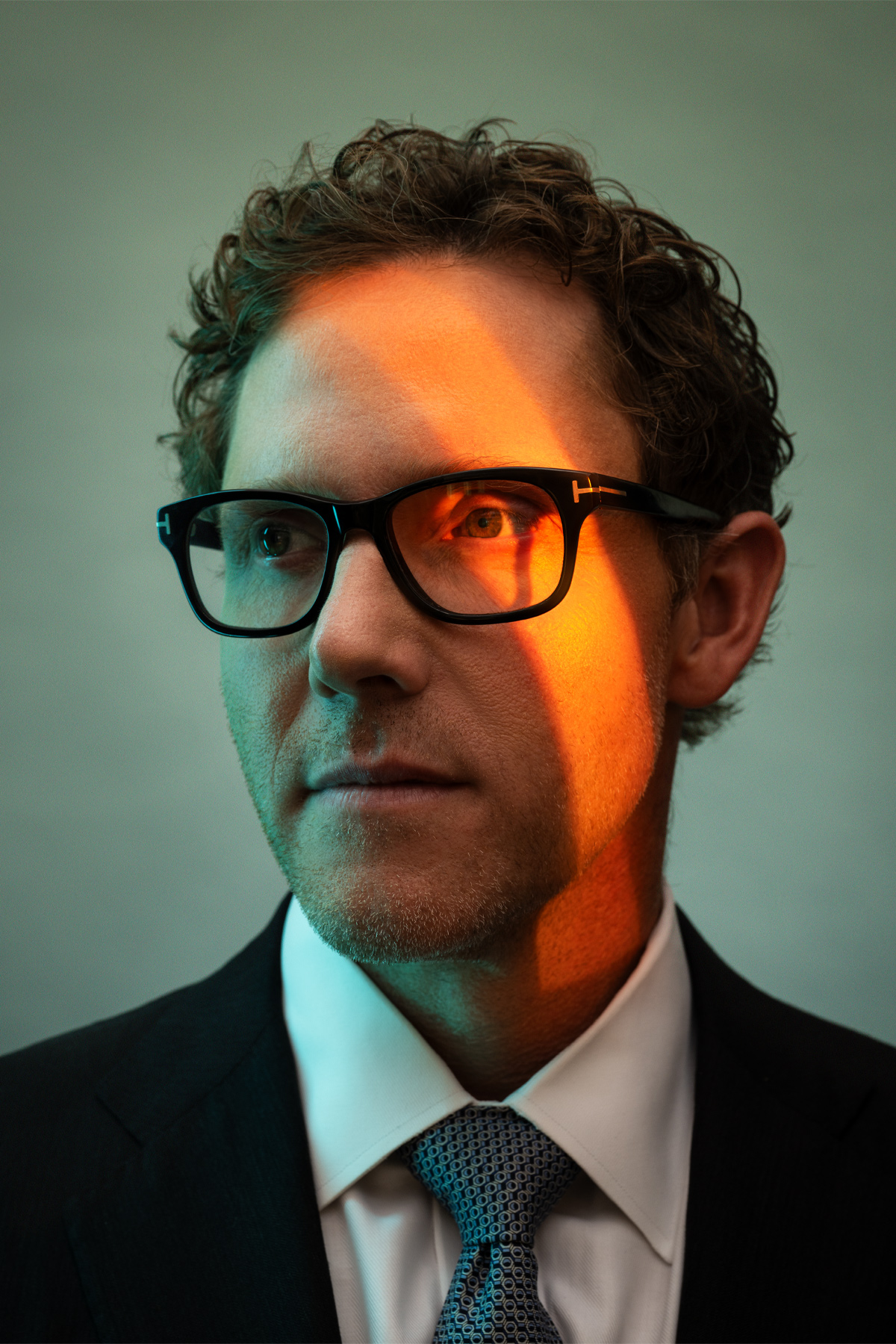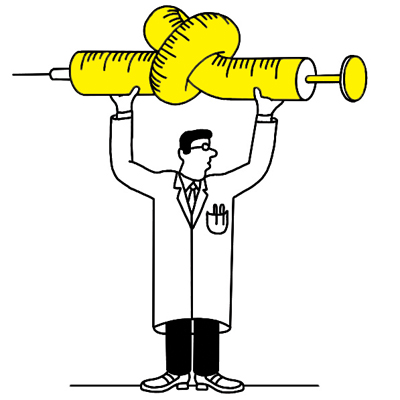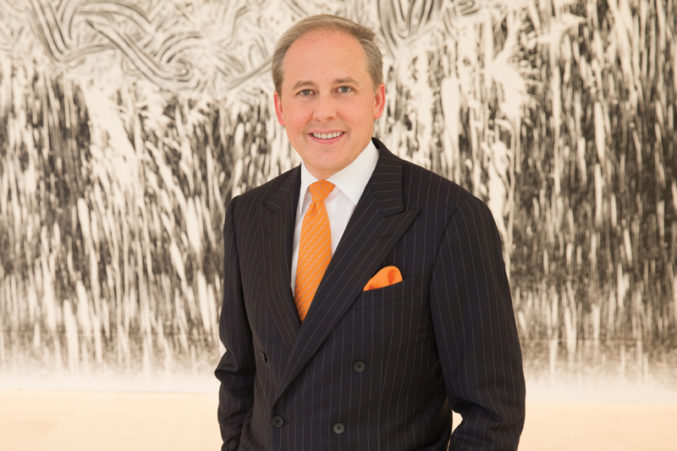
Every era has its health fads. In the 1920s, extreme calorie restriction got an assist from cigarettes. Buns of Steel VHS tapes sold like hotcakes in the late ‘80s. Just a few years ago, wellness went in a whole new, strangely amorphous direction, in which guilty pleasures could easily be excused under the guise of “self-care.” But we are now witnessing a sea change on the health scene, thanks largely to Dr. Peter Attia’s bestseller Outlive, which investigates the “science and art to longevity.” This year, when it comes to wellness, looking good is coming in second to lowering our biological age. Washboard abs are not the point; they are the byproduct of defying death.
Yet, the basic rules of health haven’t changed. Doctors still advise us to eat clean, exercise regularly, and take care of our mental health. It’s just that the game has become more sophisticated. We can invest in wearables—Oura rings to help us understand our sleep patterns or continuous glucose monitors to track our blood sugar levels. We can even scan our bodies from head to toe to detect disease. But should we? That is one of the questions we asked as we sought out Dallas health experts to help us understand how we can live our best lives, for as long as humanly possible.

The Fountain of Youth Is in Your Backyard.
Swimming has long been lauded as a healthspan-enhancing exercise. But why does a water-based workout hit different? We asked Alexander Hutchison, Ph.D., the Dallas-based editor-in-chief of the Journal of Cellular Physiology and author of The Swim Prescription.
Buoyancy
“Water lifts you up, so much so that if you get up to your neck, you’re about 90 percent unweighted. Ankles, knees, hips, and the spinal column—during the day, as we walk around, they’re always being compressed. The cartilage in the joints in between them gets squished, and they’re very poorly vascularized; they don’t have very good blood flow. So if you can physically pull them apart, then you’re actually allowing for more space for more fluid to flow into those spots. And that brings in more regenerative nutrients to allow those parts to heal.”
Thermodynamics
“Water will absorb heat very rapidly compared to air. So if you have someone who has an intolerance to heat—elderly, overweight people with neurodegenerative diseases—you stick them into a relatively cool pool, and the heat that they’re generating during their activities will be sucked out into the water. That allows them to do a longer workout at a higher intensity. When we talk about fitness, the whole point is to go as high intensity as you possibly can for the longest amount of time you possibly can, which is why we do interval training. If you want to get someone in better shape faster, it’s all about intensity and duration.”
Hydrostatic Pressure
“The deeper in water you go, the more squeeze you get. Think of it as being swaddled in a really big blanket. There’s a calming effect. If you put an EEG on somebody’s head, their brainwaves shift away from obsessive thoughts more to calming, long-term thoughts. You also get a shift of most of your blood fluids that would normally be in your legs back up into your central mass. More blood up there reduces the heart rate, and that reduces our sympathetic nervous system’s drive, which is fight or flight. Anxiety. Just being in water—you don’t even have to swim—you’re gonna get a big impact psychologically.”
Move Like Phoebe
“People talk about needing to have the right form. That’s something about exercise in general: unless you’re gonna hurt yourself, it’s more beneficial to have crappy form. Crappy form is remarkably inefficient. It burns more calories. If you’ve ever seen the Friends episode where Rachel and Phoebe go running in Central Park, and Phoebe runs like a freak—that’s how you should run because you’re expending so much more energy. If you feel like you’re hurting yourself, then talk to a coach. But if you’ve never hurt yourself before, then go ahead, have the worst technique in the world. You’ll get so much more of a workout in.”
Two Moves to Move Better
Brian Johnson is the founder of The Movement Standard, the East Dallas studio that practices the free-movement method developed by Israeli trainer Ido Portal. Here, Johnson shares simple, evidence-based daily movements that he says can save many from pain, injury, and maybe even orthopedic surgery. No gym clothes required.
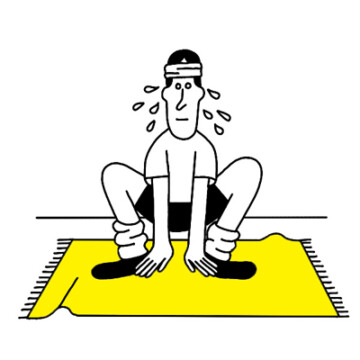
Resting Squat
Why: “You see toddlers sit in this squat with their heels flat—butt to heels. At a certain point, people quit doing it because we sit in chairs, which means there’s no reason for the knees to ever go past that 90-degree angle. You start to lose functionality because those joints want to be fully expressed. I’ve seen people go through dramatic transformations just doing that for 30 days—decreasing lower back pain, helping knees and upper spine, improving digestive function—and it’s super simple.”
How long: “Start with 10 to 20 minutes a day, accumulated time. Set a timer on your phone for 10 minutes. Let’s say you do 30 seconds in the morning and then stop the timer. Another hour later, you do another 60 seconds. The capacity for each individual is going to be different.”
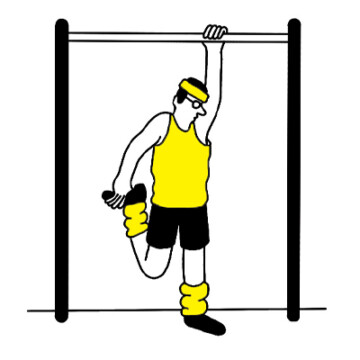
Dead Hang
Why: “The shoulder is meant to be complex. It’s meant to move freely, but the world is essentially in front of us. We don’t reach overhead very often. So hanging allows the shoulder to release and retract and allows gravity to kind of reorient the tissue from the shoulder all the way down the spine. That can help decompress and allow for more range of motion in the shoulder and the upper body. It also improves grip strength. Again, after 30 days, dramatic changes. Oftentimes pain and injury come from lack of movement.”
How long: “Five minutes a day, accumulated. A goal we’ll give people is to hang for 60 seconds without coming off the bar. But maybe somebody starts with 10 seconds and maybe with their feet in contact with the floor or a box.”
Train Your Noodle
Gains build brains, too.
Years ago, scientists believed that once the brain cells went kaput, all was lost. Newer studies, however, suggest that the brain can work around damage from, say, stroke or disease and continue making connections that will boost cognitive function.
According to Aashoo Mentreddi, a movement disorder specialist at Neurology Consultants of Dallas, “Exercise is by far the one thing that is truly evidence-based to delay the onset of certain neurological diseases. And if you do get those diseases, it is the only thing that has been proven to slow down the progression.” The reason: as you move your body, more blood heads to the brain, which increases the neurotransmitters needed for functionality.
The result is increased neuroplasticity. “That’s a fancy term for making lasting changes in the brain,” says Michael Braitsch, founder of the Tribe Wellness physical therapy clinic in Richardson. It’s the mental equivalent of touching your toes. By stretching your mind, you rewire your brain to learn new skills. That kind of brain change is the main idea at Braitsch’s clinic, which offers non-contact boxing, yoga, tai chi, and group hikes for Parkinson’s patients and aging adults.
Braitsch, a black-belt fighter who got his Ph.D. in physical therapy from UT Southwestern, says activities such as tai chi that work on coordination and balance are especially beneficial. He teaches regular tai chi classes at Klyde Warren Park; his next free session is Sunday, October 29, at 8 am.

“I’m Melting!”
Sought-after face surgeon and professor Dr. Michael Lee of Park Cities Cosmetic Surgery explains what happens to our mugs as they age. It ain’t pretty.

We start to see the effects in most people late 20s, early 30s. Around that time, we start to lose the concentration of our collagen and elastin, usually 1 to 2 percent a year. The collagen gives us volume and support. The elastin fibers are what give your tissue that kind of rubber band quality.
“It is variable how people age, but there are certain trends that the human face and neck follow. So we’ll start to see, in some areas, volume loss. Some people will have laxity to where their brow starts to settle low, and, when that happens, it kind of closes off the eyes. You also see the upper eyelids will start to get skin laxity because of the loss of elastin. You have to have enough skin on your eyelids so that you can close your eyes. With a youthful eyelid, the skin stretches, but when you open your eyes, it bounces back. As we get older, it doesn’t. The skin stretches almost in a linear fashion. Then you have this redundant skin, and over time that redundancy can hang down to your lash line.
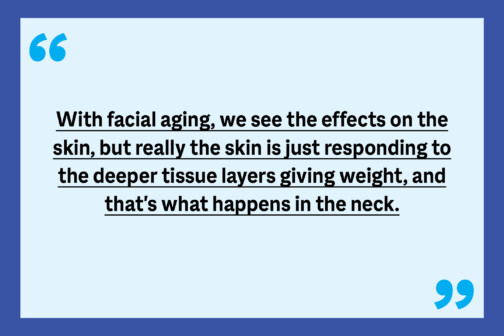
“There’s something called pretarsal show, which is how much of the eyelid we really want to see. That ideal measurement can be compromised by the excess skin. The lower eyelids are intimately related to the cheek. So when the cheek drops, it pulls with it the lower eyelid, since they’re connected. You get this elongation of the lower eyelid, which is not considered aesthetic. At the same time that’s happening, there’s this laxity of what we call the septum, which is a tissue layer that holds the fat orbit behind the lower eyelid. That fat can start to push through. We call that herniating. And now you get stretching of the skin to accommodate the fat protruding—that’s where we get the bags underneath the eyes. We get excess fat, excess skin, and a loss of tissue integrity that would naturally be supporting those in place.
“As the cheek drops, you also get more prominent nasolabial folds. The nasolabial fold is the fold that runs from the nose down to the corner of the mouth. That fold is an insertion of muscles on our face that help us smile, eat, animate. When the cheek starts to fall, those muscle insertions won’t allow the skin and the fold to go lower, so it creates more of a shadow and a more pronounced fold, which we associate with aging as well.
“Then at the same time, you have fat that’s deeper inside of the face. There’s a fat layer called the buccal fat, and it actually is part of a continuous fat pad that starts in our temporal area above our cheek and goes down into our cheek. Just like everything from top to bottom starts to respond to gravity after decades, the fat pad starts to slide down, and we get this hollowness in our temporal region. Then the bottom part of that fat pad becomes lateralized, so it moves outward through a weakening of your deeper facial tissue. There’s a muscle at the corner of our mouth that brings the corner down called the depressor angularis oris muscle, and as the fat lateralizes and falls in behind that and then falls below the mandibular border or jawline, that creates a jowl.
“A lot of times with facial aging, we see the effects on the skin, but really the skin is just responding to the deeper tissue layers giving weight, and that’s what happens in the neck. As far as other parts of the face, the ear lobes, especially in women because of earrings, they start to elongate and look disproportionate to the remainder of the ear. With the nose, you also see an elongation because we lose support of those deeper tissue layers. As you lose the support, the tip starts to fall, and you can start to see more of a bump where maybe you didn’t have a bump when you were younger. The skin of the nose will get thinner for some people as they get older. The skin across the whole face and neck is doing the same thing, which is getting thinner because of less collagen. So there’s that thinning from the collagen loss and the decrease in integrity of the tissue from the collagen loss. And then there’s the decrease in elastin, which directly influences that loss of skin elasticity.
“All of that descending is what you’re repositioning, tightening, and in some cases manipulating to achieve a more youthful and aesthetic look.”
Best Face Forward
1. Face and neck lifts are not skin lifts. Good plastic surgeons go deep, working with the fat and muscle layers. When all the layers are lifted and secured, that’s when there will be extra skin to treat. “But that’s like tailoring clothes,” Dr. Michael Lee says. “You don’t put tension on the skin. You still see that with some really overdone people.”
2. Look refreshed, not fake. “The best work is the work that you don’t know was work,” Lee says. “Maybe there are people that want to look way different, but I would say, at my practice here in Highland Park, nobody comes in and says, ‘Hey I wanna look really tight.’ ”
3. Don’t wait too long. Lee compares plastic surgery to house restoration. The longer you hold off, “the further to ground it falls. The components that you’re working with are now older and more weathered. It’s harder to pick it up and make it look normal.”
4. Use your own fat. Sparingly. The latest method to restore youth: nanofat microneedling. A patient’s fat is processed down to nanoparticles that Lee will then microneedle onto the skin of the face, neck, and décolletage.
5. Pick a specialist. Lee says New York, Los Angeles, and Dallas are the top spots for face surgery, and about 30 to 40 percent of his clientele travels from out of town. (In fact, his office sets up patients with a nutritional health coach and private duty nurse to help as they recover at the Ritz-Carlton.) While he admits it’s not ideal to follow up with post-op patients remotely, he does recommend traveling for a facelift expert rather than go to a local doc who only does a couple a month. (Lee’s average is 10 to 15 per month.)
6. Accept that there is no such thing as a perfect result. “We’re not perfect creatures to begin with,” Lee says, “and in this operation, we’re putting older tissue back where it used to be. But it’s still older tissue.”
Trial Run
We tried three now-trending treatments and then asked Dr. Omar Durani of Diamond Physicians for his professional take.
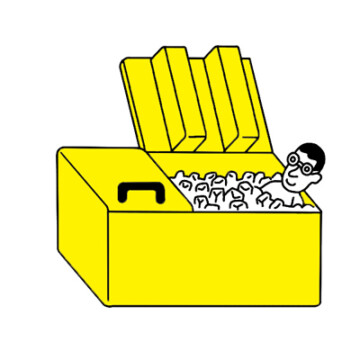
The Treatment
Cold Plunge
The treatment at SweatHouz in West Village is a little more involved than hopping in a tub of ice water. You get 15 minutes in a private room—with a shower and hot towels for post-soak—which is more than enough time to sit in the 50-degree water for the three to five minutes they suggest. (But even as little as 30 seconds can help to decrease inflammation and boost injury recovery, staff said.) When I got out, after a full six minutes, the best way to describe how I felt is shrink-wrapped. Brand new. The effect held strong for the next few days. I already want to go back and get the rest of the weekly 11 minutes they recommend. sweathouz.com
—Zac Crain
Doctor’s notes: Durani explains that a cold plunge “elicits an extreme adrenaline response” causing rapid blood vessel dilation, which increases blood flow, thus decreasing inflammation. But he notes that this is not always a good thing. “I don’t recommend cold plunges for just a random person because they saw it on their social media,” Durani says, suggesting that anyone with a history of cardiovascular issues talk to their doc before dipping. “You just want to make sure you do it judiciously.”
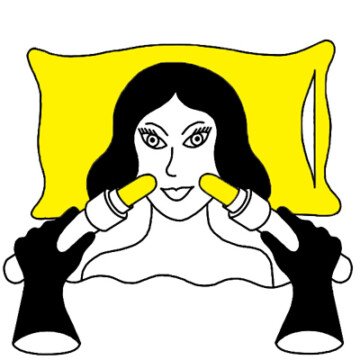
The Treatment
Lymphatic Enhancement
You can thank Hailey Bieber’s lymphatic-drainage habit for the treatment’s surge in popularity. But while Bieber’s motivations skew toward body sculpting, I was hoping for an immunity boost and better sleep. Jenny Kell of Movement Therapy recently added three new practitioners to her team to accommodate an increased demand from clients for help with post-COVID inflammation. My treatment started with a very light manual massage, and then she switched on her lymphatic enhancement therapy (LET) device, which moves lymph fluid via electrostatic energy. It felt like someone was gliding lightbulbs along my skin, but it was undoubtedly doing something: as I left Kell’s studio, my sinuses were clear after a solid week of congestion. movementtherapydallas.com
—S. Holland Murphy
Doctor’s notes: Lymphatic massages have been used in the medical setting for decades, Durani says. He compares lymph nodes to “garbage disposals,” explaining that our lymphatic vessels are meant to move excess fluid out of the body. “The massages, in theory, can help you get rid of all this accumulated junk, almost like cleaning out your gutters.”
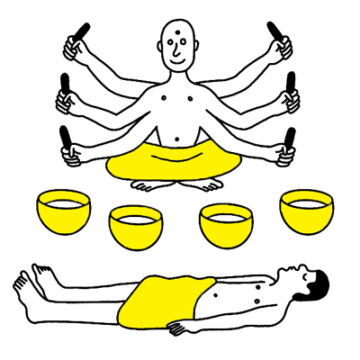
The Treatment
Sound Bath
Sound baths have been used in spiritual settings for millennia, but their wellness benefits have been plugged by modern practitioners, such as those at Breathe Meditation and Wellness, for helping with stress reduction, blood pressure, and sleep. While I lay on a squishy mat and stared at a projection of lights that looked like swirling nebulae, an instructor manually played bronze Tibetan singing bowls and other instruments. The resulting sounds echoed around the packed room. The hum was so loud it seeped through my bones. At times it was discordant and jarring; other times, soothing. I walked out a little calmer, but mostly I wondered, Did I just microdose on something? breathemeditationandwellness.com
—Catherine Wendlandt
Doctor’s notes: Durani points to small-scale EEG studies that showed sounds in the high-frequency range produced slower alpha waves in the brain, inducing a state of calm and relaxation. “There’s potentially benefits if it helps with being more present and breathing,” Durani says, “because our minds are always running 300 miles an hour.”
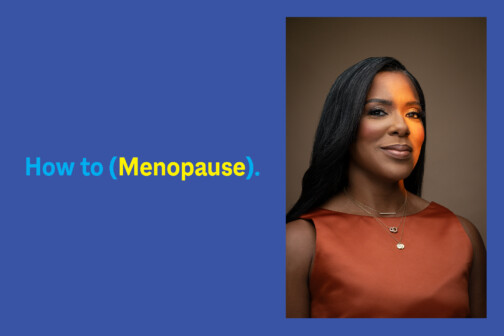
Sexual Healing
Dr. Jessica Shepherd is hunting the perimenopausal elephants in the room.
By Kathy Wise

Maybe you’ve run into Dr. Jessica Shepherd near her home in East Dallas, chasing her two adorable boys up Flag Pole Hill or enjoying a glass of wine with her striking architectural engineer husband at Cedar & Vine. Or perhaps you’ve just seen her on Today, her hair even better than host Maria Shriver’s, talking knowledgeably and comfortably about women’s sexual health. However it happened, if you’ve come across Shepherd then you know: she’s the kind of woman you want to be. Or, at least, would trust to rejuvenate your clitoris.
At Sanctum Med + Wellness on Lovers Lane, the Canadian-born gynecologist is working to bridge the border between Western and Eastern medicine, between pap smears and pelvic dry needling, hormone replacement therapy and sound baths. After six years in academic medicine, teaching in hospital systems in Chicago, she became frustrated that she was unable to transform her patients’ lives outside of the office.
“Usually when they came in, it’s some crisis,” Shepherd says. “I was always very much into the sustainability of our lives outside of illness. And it just didn’t provide a way for me to do that. So I said, ‘What is a way that we can allow people to be inspired by their journey and wellness, decrease illness, and then also create a lifestyle?’ ”
She started by researching other countries that do it better. “Europe has some really good models of how to bring aging and longevity and lifestyle into a setting where people can understand it and want to do it,” she says. “And then there is a place in New York City called The Well.” The Well offers an upscale model for nontraditional therapies that may have historically been housed in more bohemian settings. But what it lacks is a medical component.
In 2020, Shepherd left clinical practice to open Sanctum Med + Wellness across from the Inwood Village Trader Joe’s. (Her husband is a Texan, hence the move to Dallas.) There, under a subscription model (aka no insurance), patients have access to Shepherd’s gynecological expertise as well as to a registered dietician, a sex and intimacy coach, a life coach, a yoga instructor, a masseuse, a pelvic physical therapist, estheticians, and Dr. Edison Tai, a licensed acupuncturist.
“We are going to age,” Shepherd says. “But I feel we really have all the tools and resources to age gracefully, and we get to choose how we want to do that process. I think with a team and supportive environment, and an ecosystem that fosters that, that’s when we can have this beautiful outcome of aging and longevity instead of allowing ourselves to have only two states: either you’re not ill or you’re ill. There’s this big area in between. If we tune in to these systems and modalities, we actually allow ourselves a better cadence of how we feel when we’re swaying between those extremes.”
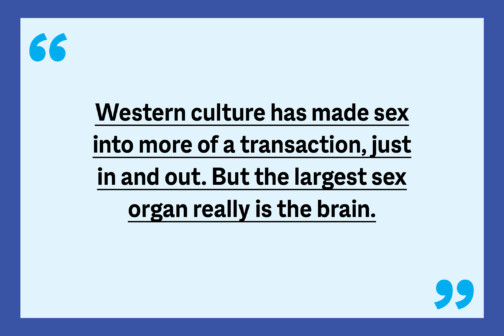
Perimenopause is a prime example of what Shepherd is seeking to redress. During this stage in women’s development, which can last for years, up to the point when the ovaries stop releasing eggs and menstruation stops for good, women often feel entirely disconnected from their bodies. The oft-hidden process is commonly talked about in unhelpful euphemisms (“the change of life,” “the second spring,” “the closing of the baby factory”) that further mystify what can be an agonizing and frightening process. Shepherd wants her patients to know that they are not alone; that what they are experiencing has a very real, physiological cause; that the combination and severity of symptoms are unique to them; and that there are a variety of medical and alternative therapies to choose from to help ease the inevitable.
One giant perimenopausal elephant in the vaginal canal is sex, which can become painful as drops in estrogen cause dryness and become less fulfilling as blood flow to the clitoris decreases, similar to what happens in the case of erectile dysfunction. Shepherd applies Western medicine in the form of laser and radiofrequency treatments to lubricate and tighten as well as to treat urinary incontinence. PRP injections—similar to the “vampire facial” microneedling process that injects platelet-rich plasma to regenerate tissue—are used to increase clitoral sensitivity. But, Shepherd says, the sex organs are only part of the sexual healing equation.
“Western culture has made sex into more of a transaction, just in and out. But the largest sex organ really is the brain. And many people don’t know how to make that connection. So when they have either had a bad sexual encounter or pain with sex, their mind is eliminated from the entire process. That’s why we integrate sex and intimacy coaching, because it’s relearning. Maybe you’ve been with your partner forever and you’re just like, ‘I want to reignite that.’ Or maybe you’ve gone through a divorce and you’re just like, ‘I don’t know how to reenter that space again.’ So we encompass all of that.”
The bedroom is just one place where our brains tend to get in the way of our health. If we don’t believe that we can eat better, or move more, or do a handstand scorpion pose, then we won’t. Shepherd’s goal, therefore, is to change the mindset before changing the action. Address the self-sabotage and the trauma, and then plot a course forward.
“I encourage people to ask themselves, ‘How do I want to show up for myself?’ and ‘How would I like to age?’ And if you’re able to answer those questions, are you doing those things?” Shepherd says. “If you’re not able to answer those questions, maybe this is somewhere where you can explore and find that answer.”
Longer Sleep Leads to a Longer Life
We asked Dr. Sonya Merrill from the Cooper Clinic how to best get our rest for the extra years.
Stay Below 70
In the middle of an intense heat wave, many Texans are keeping the thermostat higher to reduce electricity bills. But Merrill says that the optimal temperature for sleep is between 65 and 68 degrees, with 70 being the upper limit. “This has been well established in sleep studies and the sleep lab,” she says. “If you raise the thermostat even a couple of degrees, we see light, fragmented sleep.” And, no, using a fan is not a workaround. “They don’t really lower the temperature that much. They just circulate the air; they circulate dust. If they are blowing directly down on you like a ceiling fan, that actually will cause dry mouth, dry nose, and dry eyes.”
Beware of Chocolate
It’s important to be mindful of less obvious caffeine sources. “Everybody thinks about, you know, Coke or coffee,” Merrill says. But when she digs deeper into her patients’ daily routines, she often discovers that they habitually consume a less likely culprit such as iced or green tea. “I also see chocolate, particularly dark chocolate, a lot. The higher the cacao content, the more caffeine.”
Get Tested
Many people don’t have trouble falling asleep but sleep poorly through the night. Obstructive sleep apnea (OSA) is the cause for more than 30 million adults in the United States. Unfortunately, it often goes undetected. “Not everyone with OSA snores,” Merrill says. When a patient’s sleep is often interrupted for no obvious reason and not accompanied by racing or anxious thoughts, Merrill recommends an OSA evaluation, which can be done as a home sleep apnea test or as an in-lab sleep study.
Give Yourself a Break
Many people have unrealistic or negative sleep beliefs. If you expect to fall asleep the second your head hits the pillow, you might worry when it takes you 20 minutes, even though that’s still within the realm of normal sleep. This worry often prompts the use of unnecessary sleep aids and excessive time in bed. “The longer you spend in bed awake, the more frustrated you will get, and the more your natural ability to fall asleep will be inhibited,” Merrill says. Some people suffer from inappropriate activation of the mind and body that simply prevents shutting down for sleep. For all of these, the gold standard in treatment is cognitive behavioral therapy for insomnia (CBT-I). CBT-I is not basic counseling; it’s short-term (six to 10 sessions), goal-oriented, and led by an expert in behavioral sleep medicine. The treatment corrects false beliefs and bad behaviors, leading to long-term restful results.
To T or Not to T
If all you have is a hammer, everything looks like a nail. The cautionary adage applies to the quickly growing testosterone industry, where clinics that market themselves as a solution for low T will nearly always prescribe the patient testosterone treatment, even if they don’t need it or aren’t a good candidate.
Cleveland Clinic-trained urologist Dr. Dan French says he spends much of his business helping men get off testosterone because of its side effects. Despite the treatment’s connection to manliness and virility, testosterone injections harm a man’s sperm count, and dads-to-be shouldn’t be on it.
French says that looking at one’s testosterone numbers alone is too simple a calculation. Testosterone levels fluctuate throughout the day and must be considered with the patient’s symptoms, life stage, and other complicating factors. True fatigue and low sex drive are the telltale symptoms, but French says today’s expectations for energy, muscle mass, and virility are often unrealistic. A man with no symptoms and a low T number probably shouldn’t get treatment despite what the numbers say. And someone with symptoms but whose testosterone numbers fall in a normal range is likely a good candidate for treatment.
The answer, French says, is finding a urologist with the breadth of experience and knowledge to know whether the patient is a good fit and whose entire business model isn’t built on providing low T treatments.
“I worry about overtreating patients and not addressing the underlying issues,” French says. “If you have unreal expectations, a urologist will tell you, and they will end there.”
—Will Maddox
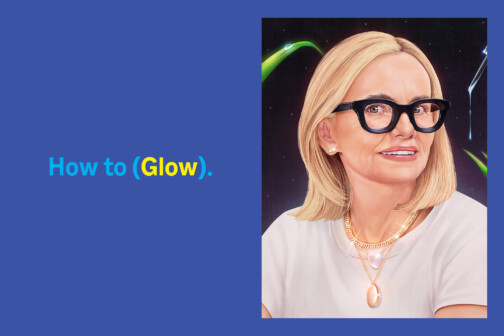
Czechisms to Live By
Poland-born, Dallas-based facialist Joanna Czech is known the world over for delivering glowing skin and “painful honesty.”
as told to S. Holland Murphy
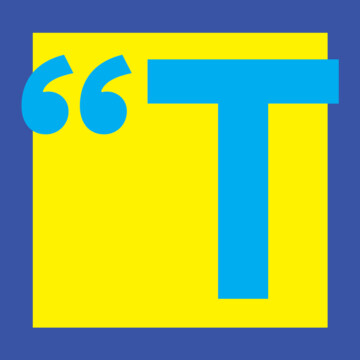
“The face starts at your nipples and ends at the hairline. You don’t need separate creams for your neck, décolletage, or the back of your hands. It is the same physiology, anatomy, and pathology, only with the slight difference that the lipid layer on the neck and décolletage is reduced 30 to 40 percent. When you use your body treatment, do your neck and down. When you do your face treatment, always nipples up. It’s not the product itself but also the motion of the application, which creates a little micro massage and micro blood flow. If you do it at least two times a day, it really makes a difference.
“Don’t bring streets to your sheets. Concentrate on nighttime routine. Little children, we bathe them at night, we read them a page of a book, and they are peaceful asleep. We are exactly the same creatures, but just as crazy humans, we keep ourself busy and collapse. But we need the same ritual to support our body. So nighttime shower, nighttime skincare, nighttime face care—that’s mandatory for any results and for our health. You want to make sure that you keep all your moisture within your skin because the main water loss happens at night. And efficacy of all the products is increased 40 to 50 percent when they are applied at night, because that’s when skin really absorbs everything during relaxation and rejuvenation time.
“Don’t do what your girlfriend does. We all have different needs, different conditions. So don’t rush to those experts because your girlfriend went and she looked good. See a specialist for everything, but choose for yourself.
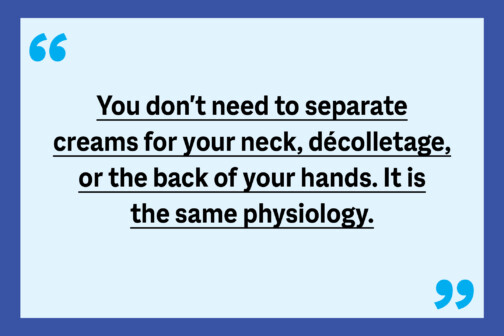
“Don’t follow trends. I don’t believe in trends in skincare. All those buzzwords—natural, healthy, friendly, organic. What? Clients walk into the studio, and I have no idea if the person is sad, smiley, happy, or not because there is no movement in the face at all. And they say, ‘Joanna, are your products clean?’ What the hell does it even mean? And I say, ‘I just dusted them off.’
“Plastic surgery at the right time. For the woman who wakes up in the morning and each time analyzes her skin, do it when there is still some elasticity left. I’m approaching 60. If I would do my surgery now, I would look like I’m walking against the wind.
“Treat the muscles like a dough and the skin like a sponge. This is from my very first instructor in Poland. Deep tissue massage bypasses the skin and has nothing to do with stretching because it reshapes the muscles and stimulates blood flow, bringing nutrients and oxygen to our muscles, to our skin. Apply some oil or serum—that’s when you can manipulate the muscle. Then, your product, you spread it, you tap a little bit, and your skin acts like a sponge.
“Lasers are so misunderstood and over-pushed. The level of hypopigmentation post-lasers—wrongfully used and just pushed on people—it’s unbelievable how many crying clients we have. And then when somebody’s addicted, you see this see-through skin without any natural color because melanocytes are burnt out. So you will never get tan, you only turn pink or white. If I can tell that somebody had something done, that’s not good. Proper form of vitamin A, microneedling, proper forms of vitamin C, face massaging, LED therapies, even PRP—all those are good. Either you were born with map of Europe on your forehead, or you really have such post-acne scarring that you don’t want to step out from home. These are the people that should do it.”
Hair Thinning or Hair Loss?
Either way, wash your hair already.
Before popping Insta-ad hair growth pills, hold up. Dr. Elizabeth Houshmand would like a word with you. The double-board-certified doc—in dermatology and internal medicine—does not take hair loss lightly. “It’s very complex,” Houshmand says. “To have healthy skin and healthy hair, you have to be healthy. If you’re sick, your body is trying to share information with you.”
During a hair evaluation, Houshmand discusses family hair history (“Hair is largely controlled by your genetics”); notes everything in your medicine cabinet (“Everyone is on these testosterone pellets, and that can affect your hair”); and considers your stressors (she’s seeing more young patients in recent years, which she attributes to pandemic and social media pressures).
Houshmand will also evaluate your scalp, looking for issues such as seborrheic dermatitis or follicle strain caused by, say, tight buns. One of her biggest bugaboos: once-a-week washers. “There’s nothing wrong with washing your hair every day if you need to, or every two to three days,” Houshmand says. “It’s the folks that wash only once a week who have buildup on their scalp. That’s where you’re clogging the actual hair follicle. I don’t know where this started, this sort of myth about washing the hair as being a bad thing. And have you seen the oil training trend? There’s nothing to train.”
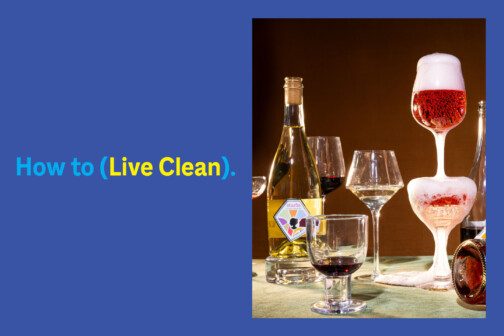
Don’t Diet
You heard it from Whitney Stuart.
By S. Holland Murphy

Ask dietitian-nutritionist Whitney Stuart which popular diet she favors—keto, paleo, the list goes on—and she will stop you short. “No full restriction of any food group is ever sustainable,” she says emphatically. “And I don’t have time for unsustainable lifestyle change.” Stuart, who has her master’s in clinical nutrition from UT Southwestern, educates her patients on the biological functions of each food group and shows them how to build plates without the dreaded D: deprivation. “I want to teach my patients how to eat all the time, not just how to eat perfectly for 20 days,” she says.
Stuart also doesn’t have time for calorie counting, point systems, or expensive diet supplements. Instead, she focuses on a biological metric: controlling blood sugar, and many of her patients—most of whom are “ultra successful women who prioritize everything but their health”—wear continuous glucose monitors. “It is the quickest way that I have seen health change because it gives live feedback, and we know that Americans love instantaneous results,” she says.
Over years of experience working with diabetes patients at an endocrinology clinic, Stuart realized that blood sugar management needed more attention in the wider wellness conversation. Here, Stuart gives us a little taste of what she calls the Blood Sugar Bliss Method.
Why Avoid Blood Sugar Spikes?
“The body can’t use the sugar in your bloodstream unless you have insulin there to let it in. It’s like the security at the door. But insulin is a growth hormone. So the less insulin resistance you have, the easier it is for your body to use your own fat storage. The more you use, the more weight you gain. It’s not just about calories in, calories out. It’s about nutrients in, nutrients out.”
Repeat After Whitney: No Lonely Carbs
“Pair that quick-burning fuel you crave with a slow-burning fuel to prevent a blood sugar spike. Craving a muffin? Have half, but first, eat two scrambled eggs. Need fries at Honor Bar’s happy hour? Pair them with kale salad and chicken. We call this ‘avoiding lonely carbs.’ Have what you want without overwhelming your insulin receptors, which chronically increases risk for metabolic syndrome.”
The Dangerous Cycle of Low-Cal Diet Systems
“Ultra low-calorie diets just don’t give the body enough sustainable nutrients. Without adequate calories or protein, you burn through muscle mass. And decreased muscle mass alone is what lowers your metabolism—your body’s daily caloric burn—which then makes it harder to lose weight without that very low-calorie diet. That’s why the diet industry is so addictive.”
The Magical Properties of Purse Jerky
“Still hungry after that 100-cal granola bar? Add high biological value protein—complete protein. Not only does protein blunt the response of carbohydrates like the bread basket and post-dinner gelato, but it’s king at turning off hunger and providing satiety. Protein is the hardest to turn into fat storage and the easiest at keeping you full. I keep grass-fed meat sticks in my purse—purse jerky, that’s right—wild tuna packets on hand, and buy eggs in bulk.”

Get Your Money’s Worth by Eating More Vegetables
“Vegetables’ best purpose is as a volume filler. We eat very small energy-dense bars that have a big price tag. Vegetables are big and have a small price tag. When you put vegetables in your stomach, it can feel fullness. The veggies take up square footage, which helps satiate the system. And they’re rich in insoluble fiber, which digests slower and increases transit time. But they’re not as good at turning off brain hunger like protein and fat.”
Party on Without a Hangover
A drink a day won’t keep the doctor away, but drinking in moderation is OK, according to Stevi Pennypacker, owner of Salt + Light Functional Nutrition. “Your body is resilient,” she says. “It’s made to detoxify. It’s made to bounce back after things are put into it that may be unhealthy for it.” One in three Americans is looking to join the sober-curious movement this year for benefits such as better sleep, clearer skin, and weight loss. If you’re the one in three and want to participate in Sober October, here are three alcohol-free, Dallas-based options that can help.
Starla Wines
If you love the taste of wine but hate being wine-drunk, try this women-owned brand that vacuums the alcohol out. Starla offers a red blend, sauvignon blanc, and sparkling rosé that can be found at Spec’s, Central Market, and Pogo’s Wine & Spirits. starlawines.com
Beyond the Bar
For those just getting into the no-booze lifestyle, this little shop in Richardson—the area’s first alcohol-free liquor store—doubles as a tasting room. You can try tequila taste-alikes and original spirits, such as owner Jenny Benningfield’s favorite, Calm, which is packed with adaptogens such as lion’s mane and ashwagandha. 101 S. Sherman St., Ste. B, Richardson. | 972-584-7914.
On the Mocks AF
The mother-daughter duo of Gabriela Richardson and Karina Hettinga started mixing up mocktails earlier this year. Take a mixology class to learn how to make your own or choose from nearly 50 options to stock a booze-free bar. (A fan favorite is the spicy mango margarita made with Jalisco 55.)
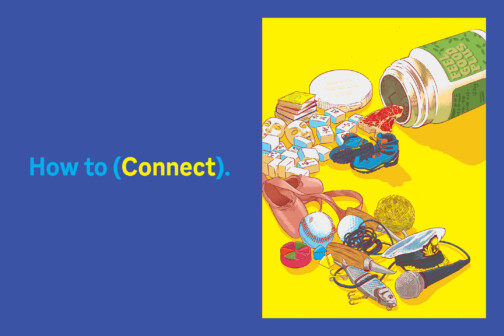
Get Connected
Social relationships have as much of an influence on our mortality as smoking and alcohol consumption. Only in a good way.

If there’s something researchers know, it’s how important your social relationships are to both your physical and your mental health,” says Heidi Kane, the director of the Close Relationships and Health Lab at UTD. “Loneliness is a key risk factor for premature mortality.” Scientists are still working to figure out why social relationships weigh so heavily on our health. In the meantime, here are some ways to get social and find friends.
Practice the “Yes, And” method in an improv class. Members of Four Day Weekend’s comedy troupe host free Saturday sessions in Dallas and Fort Worth.
Act as an onstage extra.The Dallas Opera’s supernumeraries are used in crowd scenes and get paid to boot.
Soak in syncopated rhythms. You’ll see the same cats every Wednesday at the Balcony Club’s Elite Jazz Jam hosted by bassist John Adams.
Get your mahjong on. Over a four-week series at the Jewish Community Center, Gail Mizrahi will teach you how to throw tiles with the best of them.
Take your choral skills to Carnegie Hall. No audition is required to practice with Credo Community Choir twice a month. Sign up now to get a shot at performing in the Big Apple in May.
Join a walking club. Ladies can get fit and stay safe strolling en masse with the Dallas Hot Girl Walking Club; monthly events head indoors for winter.
Test your knowledge. Thursday trivia nights at Celestial Beerworks see regular crowds of sharp minds and Alex Trebek enthusiasts. Arrive early for pregame mingling.
Find your plié people. Spend up to six weeks twirling in the Texas Ballet Theater’s adult ballet classes, ranging from true beginner to intermediate levels.
Take a hike. The Trinity River Audubon Center offers all manner of group perambulating opportunities, including reptile hikes and night hikes.
Unleash your inner poet. Dallas Poetry Slam hosts open mic nights at Twisted Bar and Grill in The Colony, where you can show off your own talents or just enjoy the show.
Spin a yarn. Knit Dallas in Lakewood Village holds crafternoons (and nights) that welcome all skill levels.
Kick it with friends. Go!
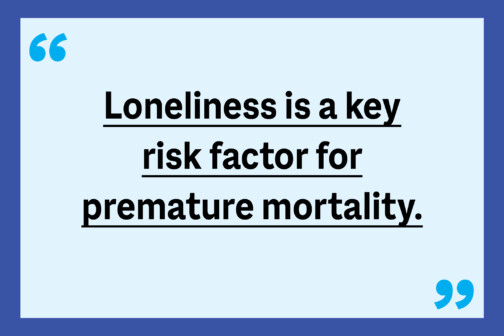
Kickball offers leagues at the JCC and Tietze Park; you can sign up as a team or solo.
Whittle me this. The North Texas Woodworkers’ Association monthly meetings give both amateur and pro carpenters a chance to show off new projects and discuss those that have them stumped.
Ahoy, you’re a sailor! Hoist the main sail and scuttle the jig during sailing classes on Lake Ray Hubbard with the North Texas sailing school.
How do you tie a fly on a tippet? The age-old question is answered every couple of weeks on the Trinity via Tailwaters Fly Fishing classes.
Get lit (as in, literature). On the last Thursday of each month, publisher Deep Vellum picks one of their own titles to dig in and discuss for the Backlist Book Club.
Swing with the misses. The Ladies League plays nine every Monday at Tenison Park Golf Course.
Get some air with ultimate Frisbee. Play a casual pickup game organized via the Dallas Ultimate Community’s Facebook group.
A Social Media Flex for Your Health
Forget SKIMS. Is it time to put on your scrubs for Prenuvo’s $2,500 full-body scan?
There were Maldives vacays and trips on a PJ (that is, private jet) and then an unusual social media flex entered the chat: full-body MRI scans. You may have seen Paris Hilton or Maria Menounos pose in front of the machine’s glowing-donut opening. Surely you saw the flurry of news stories when the influencer of all influencers donned scrubs on Insta. “What, Exactly, Does Kim Kardashian’s $2.5K Health Scan Involve?” read Vogue’s headline.
But it was our city’s own Tina Chen Craig whose social post alerted me to Prenuvo, the new medical technology company behind the scans. It was the perfect time to pique my interest. Just months before, a close blood relative had died suddenly, with no warning, of a cancer that had quietly spread through her whole body—another addition to a strong family history of cancer deaths. So a one-hour, radiation-free scan that could detect more than 500 conditions ranging from MS to colon cancer? Now that was a social media trend I was willing to jump on.
Prenuvo currently has eight locations across the country, which means many interested in preventive health are jetting here and there. It’s not the only one-hour, whole-body MRI on the market, however. Prenuvo’s leading competitor, Ezra, has more locations, though most are on either coast. But Prenuvo’s marketing team seems to have tapped into the importance of influencers, which, I’m guessing, is why doctors have now come out of the woodwork to throw water on the hot scan trend. The American College of Preventative Medicine even released a position paper to say that whole-body scanning was not recommended for those without symptoms.
But why? “People will say, well, more information is always good,” says Dr. Reuben Elovitz of Private Health Dallas. “That’s not always the case.” Elovitz, a concierge physician whose wellness exams are more comprehensive than your average doc, has many patients who have used Prenuvo at his recommendation, but only after much consideration. Elovitz points to the danger of sending patients down stressful diagnostic rabbit holes to chase the many incidental findings. “It really depends on what organ system you’re looking at,” he says. “There’s a lot of medical minutiae to explain to patients.”
For example, he says Prenuvo produces useful images in terms of the prostate, but other forms of testing are better at finding plaque in the heart. And Elovitz always has a cost-benefit conversation with patients beforehand. “It is definitely a luxury spend,” he says of the scan’s $2,499 out-of-pocket price tag (less for head- or torso-only), “and you need to have a very good understanding as to why you’re doing it.”
The evening after my scan, I got a voicemail and digital report with the breakdown of my body. Over the phone, a Prenuvo nurse practitioner explained that most of the items pinged were either common or consistent with the usual aging process. I slept better knowing nothing major showed up on my report. But staying off social media might be equally beneficial to my health. — S.H.M.
This story originally appeared in the October issue of D Magazine with the headline, “How to (Live Forever).” Write to [email protected].
Author



